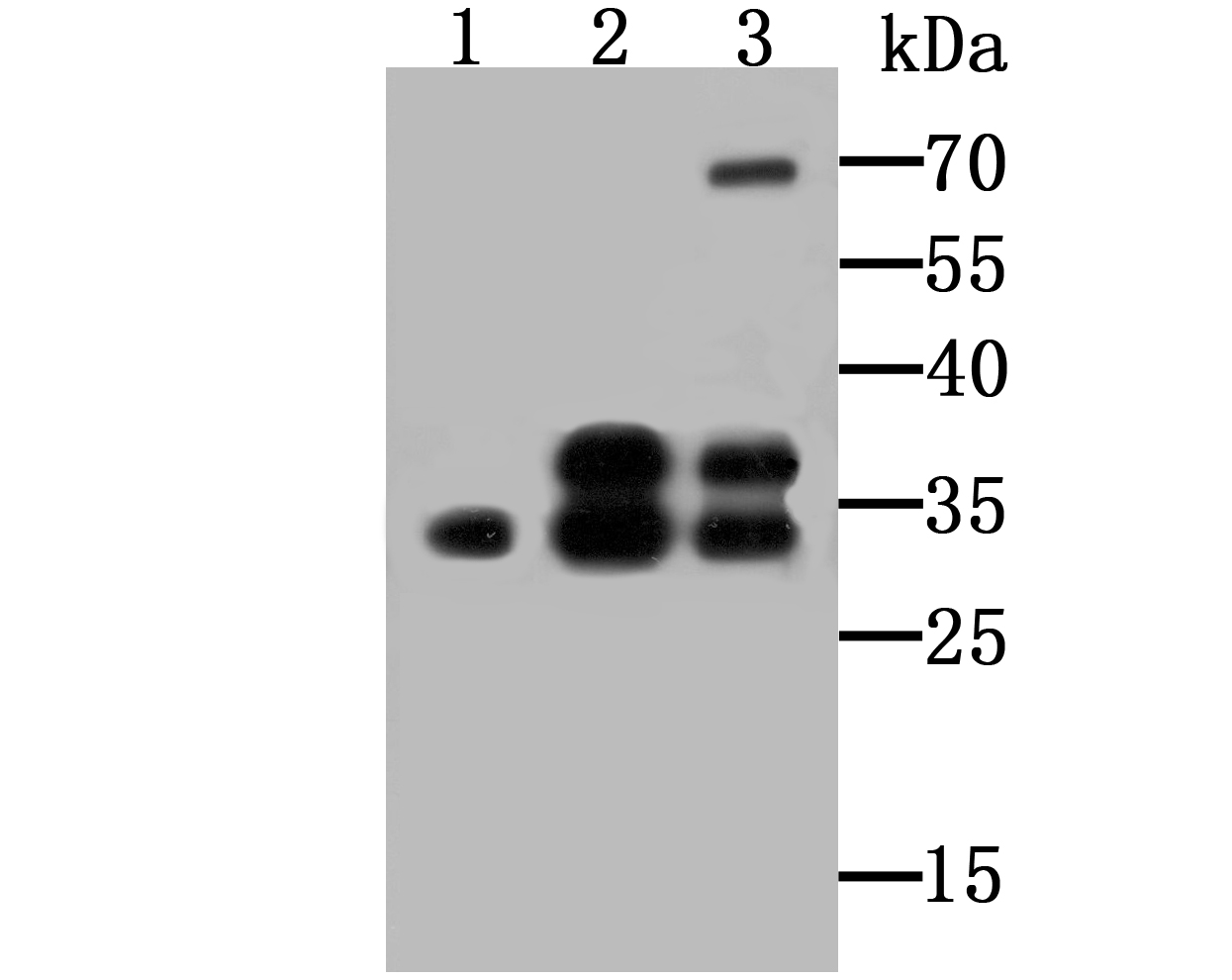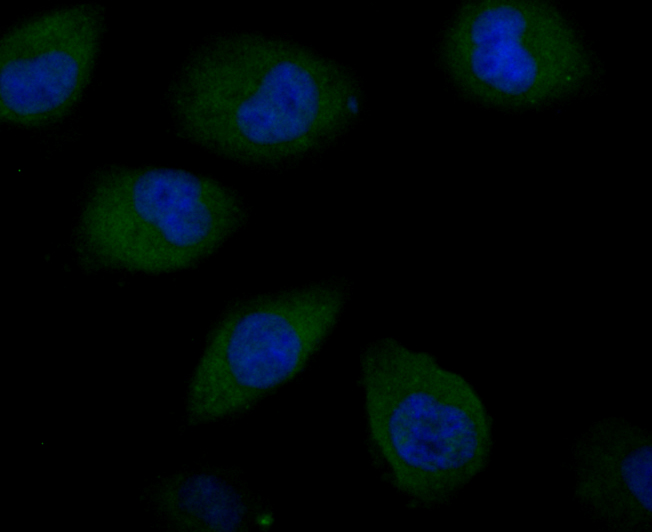Product Name :
SNAIL polyclonal antibody Background :
The Snail family of developmental regulatory proteins is a group of widely conserved zinc-finger proteins that regulate transcription and include the mammalian proteins SLUG, SNAI 1, the human homolog of Drosophila SNAIL, and Smuc. SNAI 1 and SLUG are expressed in placenta and adult heart, liver, and skeletal muscle. SNAI 1, and the corresponding mouse homolog Sna, each contain three classic zinc fingers and one atypical zinc finger, while SLUG contains five zinc finger regions and a transcriptional repression domain at the amino terminus, which enables SLUG to act as a negative regulator of gene expression. SLUG is implicated in the generation and migration of neural crest cells in human embryos and also contributes to limb bud development. In addition, SLUG also constitutes a cellular anti-apoptotic transcription factor that effectively prevents apoptosis in murine pro-B cells deprived of IL-3. The Snail-related gene from murine skeletal muscle cells, Smuc, is highly expressed in skeletal muscle and thymus and can, likewise, repress gene transcription. Smuc preferentially associates with CAGGTG and CACCTG E-box motifs (CANNTG) on DNA and involves the five putative DNA-binding zinc finger domains at the C-terminal region of Smuc. Product :
Rabbit IgG, 1mg/ml in PBS with 0.02% sodium azide, 50% glycerol, pH7.2 Storage&Stability :
Store at +4°C after thawing. Aliquot store at -20°C or -80°C. Avoid repeated freeze / thaw cycles. Specificity :
SNAIL polyclonal antibody detects endogenous levels of SNAIL protein. Immunogen :
Peptide Conjugate :
Unconjugated Modification :
Unmodification
SNAIL polyclonal antibody Background :
The Snail family of developmental regulatory proteins is a group of widely conserved zinc-finger proteins that regulate transcription and include the mammalian proteins SLUG, SNAI 1, the human homolog of Drosophila SNAIL, and Smuc. SNAI 1 and SLUG are expressed in placenta and adult heart, liver, and skeletal muscle. SNAI 1, and the corresponding mouse homolog Sna, each contain three classic zinc fingers and one atypical zinc finger, while SLUG contains five zinc finger regions and a transcriptional repression domain at the amino terminus, which enables SLUG to act as a negative regulator of gene expression. SLUG is implicated in the generation and migration of neural crest cells in human embryos and also contributes to limb bud development. In addition, SLUG also constitutes a cellular anti-apoptotic transcription factor that effectively prevents apoptosis in murine pro-B cells deprived of IL-3. The Snail-related gene from murine skeletal muscle cells, Smuc, is highly expressed in skeletal muscle and thymus and can, likewise, repress gene transcription. Smuc preferentially associates with CAGGTG and CACCTG E-box motifs (CANNTG) on DNA and involves the five putative DNA-binding zinc finger domains at the C-terminal region of Smuc. Product :
Rabbit IgG, 1mg/ml in PBS with 0.02% sodium azide, 50% glycerol, pH7.2 Storage&Stability :
Store at +4°C after thawing. Aliquot store at -20°C or -80°C. Avoid repeated freeze / thaw cycles. Specificity :
SNAIL polyclonal antibody detects endogenous levels of SNAIL protein. Immunogen :
Peptide Conjugate :
Unconjugated Modification :
Unmodification
-
 Western blot analysis of SNAI1 on different lysates using anti-SNAI1 antibody at 1/500 dilution. Positive control: Lane1: Human kidney tissue Lane2: SiHa Lane3: K562
Western blot analysis of SNAI1 on different lysates using anti-SNAI1 antibody at 1/500 dilution. Positive control: Lane1: Human kidney tissue Lane2: SiHa Lane3: K562 -
 ICC staining SNAI1 in HUVEC cells (green). The nuclear counter stain is DAPI (blue). Cells were fixed in paraformaldehyde, permeabilised with 0.25% Triton X100/PBS.
ICC staining SNAI1 in HUVEC cells (green). The nuclear counter stain is DAPI (blue). Cells were fixed in paraformaldehyde, permeabilised with 0.25% Triton X100/PBS.
Bioworld Biotech only provide peptides for our antibodies and do not provide additional peptide customization services.
Price/Size :
USD 368/1mg/vial
Tips:
For phospho antibody, we provide phospho peptide(0.5mg) and non-phospho peptide(0.5mg).Describe :
Blocking peptides are peptides that bind specifically to the target antibody and block antibody binding. These peptide usually contains the epitope recognized by the antibody. Antibodies bound to the blocking peptide no longer bind to the epitope on the target protein. This mechanism is useful when non-specific binding is an issue, for example, in Western blotting (WB) and Immunohistochemistry (IHC). By comparing the staining from the blocked antibody versus the antibody alone, one can see which staining is specific; Specific binding will be absent from the western blot or IHC performed with the neutralized antibody.Formula:
Synthetic peptide was lyophilized with 100% acetonitrile and is supplied as a powder. Reconstitute with 0.1 ml DI water for a final concentration of 10 mg/ml.The purity is >90%,tested by HPLC and MS.
Storage:
The freeze-dried powder is more stable. For short time at 2-8°C. For long term storage store at -20°C.
Note :
This product is for research use only (RUO only). Not for use in diagnostic or therapeutic procedures.
 SNAIL polyclonal antibody
SNAIL polyclonal antibody  Datasheet
Datasheet COA
COA MSDS
MSDS SHIP
SHIP